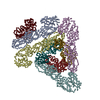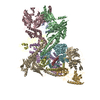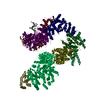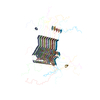[English] 日本語
 Yorodumi
Yorodumi- EMDB-1929: Modular architecture of eukaryotic RNase P and RNase MRP revealed... -
+ Open data
Open data
- Basic information
Basic information
| Entry | Database: EMDB / ID: EMD-1929 | |||||||||
|---|---|---|---|---|---|---|---|---|---|---|
| Title | Modular architecture of eukaryotic RNase P and RNase MRP revealed by electron microscopy | |||||||||
 Map data Map data | RNase P Ribonuclease P Ribonuclease P | |||||||||
 Sample Sample |
| |||||||||
 Keywords Keywords |  RNase P / RNA-processing / RNase P / RNA-processing /  ribozyme ribozyme | |||||||||
| Biological species |   Saccharomyces cerevisiae (brewer's yeast) Saccharomyces cerevisiae (brewer's yeast) | |||||||||
| Method |  single particle reconstruction / single particle reconstruction /  cryo EM / cryo EM /  negative staining / Resolution: 17.0 Å negative staining / Resolution: 17.0 Å | |||||||||
 Authors Authors | Hipp K / Galani K / Batisse C / Prinz S / Bottcher B | |||||||||
 Citation Citation |  Journal: Nucleic Acids Res / Year: 2012 Journal: Nucleic Acids Res / Year: 2012Title: Modular architecture of eukaryotic RNase P and RNase MRP revealed by electron microscopy. Authors: Katharina Hipp / Kyriaki Galani / Claire Batisse / Simone Prinz / Bettina Böttcher /  Abstract: Ribonuclease P (RNase P) and RNase MRP are closely related ribonucleoprotein enzymes, which process RNA substrates including tRNA precursors for RNase P and 5.8 S rRNA precursors, as well as some ...Ribonuclease P (RNase P) and RNase MRP are closely related ribonucleoprotein enzymes, which process RNA substrates including tRNA precursors for RNase P and 5.8 S rRNA precursors, as well as some mRNAs, for RNase MRP. The structures of RNase P and RNase MRP have not yet been solved, so it is unclear how the proteins contribute to the structure of the complexes and how substrate specificity is determined. Using electron microscopy and image processing we show that eukaryotic RNase P and RNase MRP have a modular architecture, where proteins stabilize the RNA fold and contribute to cavities, channels and chambers between the modules. Such features are located at strategic positions for substrate recognition by shape and coordination of the cleaved-off sequence. These are also the sites of greatest difference between RNase P and RNase MRP, highlighting the importance of the adaptation of this region to the different substrates. | |||||||||
| History |
|
- Structure visualization
Structure visualization
| Movie |
 Movie viewer Movie viewer |
|---|---|
| Structure viewer | EM map:  SurfView SurfView Molmil Molmil Jmol/JSmol Jmol/JSmol |
| Supplemental images |
- Downloads & links
Downloads & links
-EMDB archive
| Map data |  emd_1929.map.gz emd_1929.map.gz | 3.3 MB |  EMDB map data format EMDB map data format | |
|---|---|---|---|---|
| Header (meta data) |  emd-1929-v30.xml emd-1929-v30.xml emd-1929.xml emd-1929.xml | 9.1 KB 9.1 KB | Display Display |  EMDB header EMDB header |
| Images |  1929.png 1929.png | 109.9 KB | ||
| Archive directory |  http://ftp.pdbj.org/pub/emdb/structures/EMD-1929 http://ftp.pdbj.org/pub/emdb/structures/EMD-1929 ftp://ftp.pdbj.org/pub/emdb/structures/EMD-1929 ftp://ftp.pdbj.org/pub/emdb/structures/EMD-1929 | HTTPS FTP |
-Related structure data
- Links
Links
| EMDB pages |  EMDB (EBI/PDBe) / EMDB (EBI/PDBe) /  EMDataResource EMDataResource |
|---|
- Map
Map
| File |  Download / File: emd_1929.map.gz / Format: CCP4 / Size: 6.4 MB / Type: IMAGE STORED AS FLOATING POINT NUMBER (4 BYTES) Download / File: emd_1929.map.gz / Format: CCP4 / Size: 6.4 MB / Type: IMAGE STORED AS FLOATING POINT NUMBER (4 BYTES) | ||||||||||||||||||||||||||||||||||||||||||||||||||||||||||||||||||||
|---|---|---|---|---|---|---|---|---|---|---|---|---|---|---|---|---|---|---|---|---|---|---|---|---|---|---|---|---|---|---|---|---|---|---|---|---|---|---|---|---|---|---|---|---|---|---|---|---|---|---|---|---|---|---|---|---|---|---|---|---|---|---|---|---|---|---|---|---|---|
| Annotation | RNase P | ||||||||||||||||||||||||||||||||||||||||||||||||||||||||||||||||||||
| Voxel size | X=Y=Z: 2.2 Å | ||||||||||||||||||||||||||||||||||||||||||||||||||||||||||||||||||||
| Density |
| ||||||||||||||||||||||||||||||||||||||||||||||||||||||||||||||||||||
| Symmetry | Space group: 1 | ||||||||||||||||||||||||||||||||||||||||||||||||||||||||||||||||||||
| Details | EMDB XML:
CCP4 map header:
| ||||||||||||||||||||||||||||||||||||||||||||||||||||||||||||||||||||
-Supplemental data
- Sample components
Sample components
-Entire : RNase P
| Entire | Name: RNase P Ribonuclease P Ribonuclease P |
|---|---|
| Components |
|
-Supramolecule #1000: RNase P
| Supramolecule | Name: RNase P / type: sample / ID: 1000 / Number unique components: 1 |
|---|---|
| Molecular weight | Theoretical: 410 KDa |
-Macromolecule #1: Ribonuclease P
| Macromolecule | Name: Ribonuclease P / type: protein_or_peptide / ID: 1 / Name.synonym: RNase P / Oligomeric state: monomer / Recombinant expression: No |
|---|---|
| Source (natural) | Organism:   Saccharomyces cerevisiae (brewer's yeast) / synonym: Baker's yeast / Organelle: Nucleus Saccharomyces cerevisiae (brewer's yeast) / synonym: Baker's yeast / Organelle: Nucleus |
| Molecular weight | Theoretical: 410 KDa |
-Experimental details
-Structure determination
| Method |  negative staining, negative staining,  cryo EM cryo EM |
|---|---|
 Processing Processing |  single particle reconstruction single particle reconstruction |
| Aggregation state | particle |
- Sample preparation
Sample preparation
| Buffer | pH: 7.5 Details: 50 mM Tris HCl pH 7.5, 100 mM NaCl, 10 mM MgCl2, 1 mM DTT |
|---|---|
| Staining | Type: NEGATIVE Details: sandwich, cryo negative stain with 1% uranyl acetate |
| Grid | Details: 400 mesh copper grid |
| Vitrification | Cryogen name: NITROGEN / Chamber temperature: 95 K / Instrument: OTHER Method: samples were stained and frozen after partly drying, by dipping grids into liquid nitrogen |
- Electron microscopy
Electron microscopy
| Microscope | FEI/PHILIPS CM200FEG |
|---|---|
| Electron beam | Acceleration voltage: 200 kV / Electron source:  FIELD EMISSION GUN FIELD EMISSION GUN |
| Electron optics | Illumination mode: FLOOD BEAM / Imaging mode: BRIGHT FIELD Bright-field microscopy / Cs: 2 mm / Nominal defocus max: 1.1 µm / Nominal defocus min: 0.68 µm / Nominal magnification: 66000 Bright-field microscopy / Cs: 2 mm / Nominal defocus max: 1.1 µm / Nominal defocus min: 0.68 µm / Nominal magnification: 66000 |
| Sample stage | Specimen holder: side entry, liquid nitrogen cooled / Specimen holder model: GATAN LIQUID NITROGEN |
| Temperature | Min: 95 K / Max: 95 K / Average: 95 K |
| Alignment procedure | Legacy - Astigmatism: astigmatism was corrected at 200000 times magnification on carbon film |
| Image recording | Category: CCD / Film or detector model: GENERIC TVIPS (2k x 2k) / Number real images: 1861 / Average electron dose: 20 e/Å2 / Bits/pixel: 12 |
| Tilt angle min | 0 |
| Tilt angle max | 0 |
- Image processing
Image processing
| CTF correction | Details: each particle, phase flipping |
|---|---|
| Final reconstruction | Applied symmetry - Point group: C1 (asymmetric) / Algorithm: OTHER / Resolution.type: BY AUTHOR / Resolution: 17.0 Å / Resolution method: FSC 0.5 CUT-OFF / Software - Name: spider, imagic, xmipp Details: final maps were calculated from 20 defocus groups, number of particles in certain orientations were limited to counterbalance preferred orientations Number images used: 24373 |
| Details | particle were selected automatically, particle orientations were determined by projection matching |
 Movie
Movie Controller
Controller












